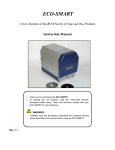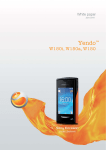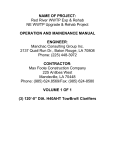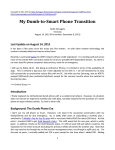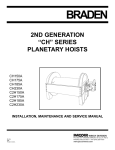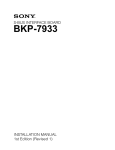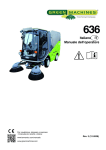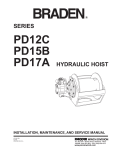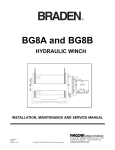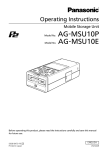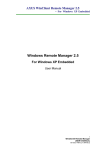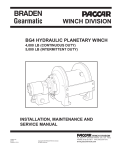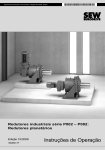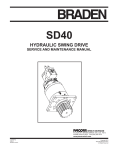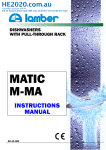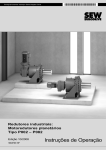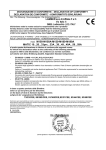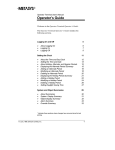Download Braden winch or this manual
Transcript
RECOVERY WINCH INSTALLATION, OPERATION, AND PREVENTATIVE MAINTENANCE MANUAL This manual must always accompany winch and remain within easy access of winch operator. Read and understand this manual before installing, operating, or servicing your Braden recovery winch. PB-162 R3 4/2010 Printed in U.S.A. 1 FOREWORD Read and understand this entire manual before operating or servicing your Braden winch. Retain this manual for future reference. The minimum service intervals specified are for operating hours of the prime mover. This manual contains installation, operation and preventive maintenance instructions for most current model Braden Worm Gear winches. As there are many product variations, you must become familiar with your Braden winch to fully benefit from the information contained in this publication. Some illustrations in this manual may show details or attachments which may be different from your winch. Also, some components may be removed for illustrative purposes. Whenever a question arises regarding your Braden winch or this manual, please contact your nearest Braden dealer of the Braden Service Department at 918-251-8511, Monday-Friday, 8:00 am to 4:30 p.m. CST, or by FAX at 918-259-1575. Provide the complete winch model and serial number when making inquiries. Parts and Service Braden provides parts and service through a network of authorized dealers. Parts and service are not available directly from Braden. For the name of your nearest dealer, consult your local phone directory or call Braden at the phone number shown above. TABLE OF CONTENTS GENERAL SAFETY RECOMMENDATIONS . . . . . . . . . . . . . . . . . . . . . . . . . 3 WORM GEAR WINCH TERMINOLOGY . . . . . . . . . . . . . . . . . . . . . . . . . . . . 5 THEORY OF OPERATION . . . . . . . . . . . . . . . . . . . . . . . . . . . . . . . . . . . . . . . . 5 WINCH MODEL NUMBER AND ASSEMBLY IDENTIFICATION . . . . . . . 7 WINCH OPERATION Drum Clutch Operation . . . . . . . . . . . . . . . . . . . . . . . . . . . . . . . . . . . . . 10 Basic Winch Operating Method . . . . . . . . . . . . . . . . . . . . . . . . . . . . . . . 12 Winch Break-In . . . . . . . . . . . . . . . . . . . . . . . . . . . . . . . . . . . . . . . . . . . 13 Capstan Use . . . . . . . . . . . . . . . . . . . . . . . . . . . . . . . . . . . . . . . . . . . . . 13 Auxiliary Rigging . . . . . . . . . . . . . . . . . . . . . . . . . . . . . . . . . . . . . . . . . . 14 WINCH INSTALLATION . . . . . . . . . . . . . . . . . . . . . . . . . . . . . . . . . . . . . . . . . . 16 PREVENTATIVE MAINTENANCE Recommended Preventative Maintenance Intervals . . . . . . . . . . . . . . . 26 Worm Shaft End-Play Adjustment . . . . . . . . . . . . . . . . . . . . . . . . . . . . . 27 Safety Brake Service & Adjustment . . . . . . . . . . . . . . . . . . . . . . . . . . . . 28 Assembly Change Instructions . . . . . . . . . . . . . . . . . . . . . . . . . . . . . . . . 32 SPECIFICATIONS Recommended Worm Gear Oil . . . . . . . . . . . . . . . . . . . . . . . . . . . . . . . .34 Recommended Fastener Torque . . . . . . . . . . . . . . . . . . . . . . . . . . . . . . 35 Oil Capacity and Worm Shaft End-Play . . . . . . . . . . . . . . . . . . . . . . . . . 36 Common Hydraulic Equations . . . . . . . . . . . . . . . . . . . . . . . . . . . . . . . . 37 Metric Conversion Chart . . . . . . . . . . . . . . . . . . . . . . . . . . . . . . . . . . . . 38 Maximum Line Speed and Torque Information . . . . . . . . . . . . . . . . . . . . 39 2 GENERAL SAFETY RECOMMENDATIONS Safety informational callouts in this manual include: CAUTION Caution – This emblem is used to warn against potential or unsafe practices which could result in injury and product or property damage if proper procedures are not followed. Warning – This emblem is used to warn against hazards and unsafe practice which could result in severe injury or death if proper procedures are not followed. Safety for operators and ground personnel is of prime concern. Always take the necessary precautions to ensure safety of others as well as yourself. To ensure safety, the prime mover and winch must be operated with care and concern by the operator for the equipment and a thorough knowledge of the machine’s performance capabilities. The following recommendations are offered as a general safety guide. Local rules and regulations will also apply. 6. On machines having hydraulically, mechanically and/or cable controlled equipment or attachments, be certain the equipment is blocked securely before servicing, adjusting and/or repairing the winch. Always apply the parking brakes before dismounting a vehicle. 7. Inspect rigging and winch at the beginning of each work shift. Defects should be corrected immediately. 8. Keep equipment in good operating condition. Perform scheduled servicing and adjustments listed in the “Preventive Maintenance” section of this manual. Failure to obey the following safety recommendations may result in property damage, injury, or death. 9. An equipment warm-up procedure is recommended for all start-ups and essential at ambient temperatures below +40°F (5°C). Refer to “Warm-Up Procedure” listed in the “Preventive Maintenance” section of this manual. 1. Read all warning tag information and become familiar with all controls before operating winch. 2. Never attempt to clean oil or perform any maintenance on a machine with the engine or prime mover running, unless instructed to do so in this manual. 10. Worm gear winch clutches may disengage and drop or lose control of a load if they are not fully engaged at the beginning of a lift or pull. The winch operator must visually determine that the clutch is fully engaged before lifting or pulling a load. Check drum clutch to be certain that the negative draft angle is clearly evident on the clutch and drum lugs. Replace a worn sliding clutch, clutch plate or cable drum. Do not use the winch if the negative draft angle is worn straight or the edges of the clutch lugs are rounded or chipped. 3. Never operate winch controls unless you are properly positioned at the operators station and you are sure personnel are clear of the work area. 4. Assure that personnel who are responsible for hand signals are clearly visible and that the signals to be used are thoroughly understood by everyone. 11. The winches described herein are neither designed nor intended for use or application to equipment used in the lifting or moving of persons. 5. Ground personnel should stay in view of the operator and clear of winch drum. Do not allow ground personnel near winch line under tension. A safe distance of at least 1-1/2 times the length of the unspoiled cable should be maintained. 12. Do not exceed the maximum pressure, PSI (kPa), or flow, GPM (LPM), stated in the winch specifications for hydraulically driven winches. 3 13. Match winch line speeds to job conditions. 22. “Deadman” controls, which automatically shut off power to the capstan drive or winch whenever the operator leaves his station, should be installed whenever possible. 14. Leather gloves should be used when handling winch cable. 15. Never attempt to handle winch cable when the hook end is not free. Keep all parts of body and clothing clear of cable rollers, cable entry area of fairlead and winch drum. 23. Never allow anyone to stand under a suspended load. 24. Avoid sudden “shock” loads or attempting to “jerk” a load free. This type of operation may cause heavy loads in excess of rated capacity, which may result in failure of cable and/or winch. 16. When winding winch cable on the winch drum. Never attempt to maintain tension by allowing winch cable to slip through hands. Always use “hand-over-have” technique, being careful to keep hands and clothing away from winch drum and fairlead rollers. 25. Whenever possible, install the capstan drive or winch in a location where the rotating capstan shaft or extension shaft is not adjacent to a “normal” operators station. 17. Never use winch cable with broken strands. Replace winch cable. 26. All winch and/or capstan controls shall be located within easy reach of the operator. The controls shall be installed in such a location that the operator is removed from the electrical path to ground if the load, rigging, cable or rope come in contact with or within proximity to an energized conductor. 18. Do not weld on any part of the winch. 19. Use recommended hydraulic oil and gear lubricant. 20. Appropriate guards should be installed around exposed portions of an extension shaft and/or capstan shaft. Install guarding to prevent personnel from getting any part of body or clothing caught at a point where rope is wound onto a capstan, cable is wound onto a cable drum or where rope and/or cable is drawn through guide rollers. 27. All rope used on a capstan must be non-conducting such that the operator is removed from the electrical path to ground if the load, rigging or rope come in contact with or within proximity to an energized conductor. 21. Install switches or valves which will shut off power to the drive or winch in locations where they can be reached by anyone entangled in the rope or cable before being drawn onto the capstan, cable drum, guide rollers or any “pinch point”. 4 WORM GEAR WINCH TERMINOLOGY AND THEORY OF OPERATION The model shown above is a MS50-2B R RA Terminology Often Used With Worm Gear Winches: The illustration shown above points out the basic components of a typical upright worm gear winch. Torque is applied to the input end of the worm shaft by a PTO driven sprocket and chain or a hydraulic or electric motor. The steel worm and worm shaft are supported by anti-friction roller bearings. Tapered bearings are shown in this illustration while ball bearings and needle roller bearings may be used on other models. As the steel worm turns, the “threads” push or pull the aluminum-bronze alloy worm gear. The worm gear is keyed to the drum shaft which is supported on bronze bushings in the worm gear housing and bearing leg. A sliding dog-type clutch is splined or keyed to the cable drum shaft. The drum clutch transmits the torque of the worm gear to the cable drum. Starting Input Torque – The torque applied to the winch input shaft required to start a rated load upward from a suspended position. It is expressed in pound-feet, pound-inches, kilogram-meters or Newton-meters. May be referred to as static torque. Running Input Torque – The torque applied to the winch input shaft required to maintain upward movement of rated load. It is expressed in pound-feet, pound-inches, kilogram-meters or Newton-meters. May also be referred to as dynamic torque. Rated Input Speed – The maximum permissible input speed at rated load expressed in RPM. Exceeding rated input speed may cause damage to the worm gear set. An oil cooled automatic safety brake is installed on the end of the worm shaft on most winches with a 12,000 pound (5,444 Kg) or greater rated capacity. The majority of the worm gear winch’s load holding ability is achieved by the inability to back-drive the worm gear set. The safety brake provides additional resistance to rotation of the worm shaft and absorbs the inertia of the PTO gear train if so equipped. A band-type brake or small shoe-type brake is installed on most worm gear winches to reduce wire rope “birdnesting” when the drum clutch is disengaged to pull wire rope out by hand. These drum brakes are NOT designed for load holding. Full Drum or Maximum Layers – A drum containing the maximum number of cable layers which would leave a freeboard of 0.7 x the cable diameter below the drum flange. Drum Storage Capacity – The maximum length of wire rope which may be wound on a cable drum without exceeding the maximum number of layers. It is expressed in feet or meters. 5 Layer – All wraps on the same level between drum flanges. Rated Line Pull – The line pull on any layer that results from the output torque which produces maximum rated line pull on the first layer. Rated first layer line pull is based on maintaining an acceptable structural safety factor while providing an acceptable component service life. Line pull is expressed in pounds or kilograms. Freeboard – The amount of drum flange that extends radially past the last layer of wire rope. Mean Drum – A theoretical point located midway between the first layer of wire rope on the cable drum barrel and the top layer. Often used as a reference point in measuring winch performance. Rated Line Speed – The line speed on any specific layer that results from rated input speed. It is expressed in feet/minute or meters/minute. Gear Set Efficiency – The relationship between the input horsepower transmitted to the winch by the prime mover and the output horsepower transmitted by the winch to the wire rope. Expressed as a percentage. Thermal Rating (Duty Cycle) – The result of a test, expressed as the distance (feet or meters) a load travels up and down while hoisting and lowering a specified weight until the lubricating oil rises from 100°F to 250°F (38°C to 121°C). 250°F (121°C) is the maximum intermittent gear oil temperature allowed. Most gear oils “break down” rapidly at higher temperatures and seals may be damaged. Largest Recommended Wire Rope Size – Should be no larger than 1/8th the cable drum barrel diameter for most recovery applications. Extension Shaft – the standard cable drum shaft is extended or replaced by an extra long shaft which permits the use of capstans or CR reels at the side of the vehicle. Usually installed on the curb side of the vehicle, most extension shafts are limited to an standard length of 44 to 46-1/2 in. (112-118 cm) from the cable drum center-line. Drum Clutch – Also known as a “dog-clutch” or “jaw clutch”, consists of two or more drive lugs which engage similar driven lugs to transmit torque to the cable drum. Capstan – Usually a small removable drum used to apply force to fiber rope wrapped around the barrel with tension applied by hand. Most have a nominal barrel diameter of 7 in. (178 mm). Free Spooling – The operation of manually unspooling wire rope from the cable drum by pulling on the free end of the rope while the cable drum is disconnected (declutched) from its power train. CR Reel – Collapsible recovery reels are used for picking up and coiling power and telephone lines which have been removed from the poles and lowered to the ground. Most CR (reels have a nominal barrel diameter of 20 in. (508 mm). Wrap – A single coil of wire rope wound on a drum. “Bull Gear” – Bronze alloy gear powered by the steel worm. Braden refers to the “bull gear” as the worm gear. Fleet Angle – That angle between the wire rope’s position at the extreme end wrap on a drum, and a line drawn perpendicular to the axis of the drum through the center of the nearest fixed sheave or load attachment point. (Refer to illustration below.) 6 WINCH MODEL NUMBER AND ASSEMBLY IDENTIFICATION Braden worm gear winches are identified by model and serial number stamped into a smooth surface near the top of the worm gear housing. The winch model number and serial number must be referenced when ordering service parts or requesting information. Do not try to identify a Braden winch by using a raised or foundry casting number. LOW MOUNT MODEL A M S U 3 - A - DESIGN TESTED TO SAE J706A 10 F EB R RA RA - RIGHT HAND ASSEMBLY LA - LEFT HAND C - CONVERTIBLE BASE E - ELECTRIC DRIVE H - HYDRAULIC DRIVE L - LIGHTWEIGHT HOUSING M - MECHANICAL DRIVE ASSEMBLY R - RIGHT HAND GEAR CUT L - LEFT HAND GEAR CUT EB - EXTENSION SHAFT ONE SIDE ONLY EEB - EXTENSION SHAFT BOTH SIDES SPL - SPECIAL G - REVISED GEAR PROFILE S - SPACER ADDED BETWEEN WORM GEAR AND HOUSING U - UNDERSLUNG OR LOW MOUNT F - FRONT OR BUMPER MOUNT IN MOST COMMON INSTALLATION 3 - BASIC MODEL NUMBER 10 - 10 IN. NOMINAL DRUM BARREL LENGTH BETWEEN DRUM FLANGES 7 UPRIGHT WINCHES UPRIGHT A M S 1 0 MODEL - 18 B * L LA LA A - DESIGN TESTED TO SAE J706A - LEFT HAND ASSEMBLY RA - RIGHT HAND BR - BRADEN SPEED REDUCER, DRUM FURNISHED BY CUST. C - CONVERTIBLE BASE E&EC - HIGH EFFICIENCY CONSTANT DUTY H - HYDRAULIC DRIVE M - MECHANICAL DRIVE MF - MARINE FISHING INDUSTRY DESIGN OS - OSHA SPEC DRUM UT - UTILITY INDUSTRY REDUCER (DRUM OFTEN FURNISHED BY CUSTOMER) ASSEMBLY R - RIGHT HAND GEAR CUT L - LEFT HAND GEAR CUT EB - EXTENSION SHAFT ONE SIDE ONLY EEB - EXTENSION SHAFT BOTH SIDES SPL - SPECIAL --- UNIT CONTROLLED DRUM CLUTCH ADJUSTABLE SHOE TYPE DRUM BRAKE A - REMOTE CONTROLLED DRUM CLUTCH SHOE TYPE DRUM BRAKE B - REMOTE CONTROLLED ADJUSTABLE BAND-TYPE DRUM BRAKE AND DRUM CLUTCH S - SPACER ADDED BETWEEN WORM GEAR AND HOUSING 10 - BASIC WINCH MODEL 18 - 18 IN. NOMINAL DRUM BARREL LENGTH BETWEEN DRUM FLANGES 8 GEAR CUT INFORMATION The following information will help you determine the cut of thread direction of the worm and worm gear and the assembly configuration of the worm gear housing designated in the winch model number. Example: R (LA) – right cut gear set, left hand assembly. 1. All winch model assembly designations are specified for standing at the rear of the vehicle, looking forward. Left side is often referred to as driver or street side; right side may be referred to as passenger or curb side. 2. The assembly designation for the winch (RA, LA) describes which side of the winch the worm gear housing is installed on. Generally the worm gear housing is matched to the same side the power take-off is mounted to the transmission to make routing of hoses or dive lines easier. If the PTO is mounted to the right hand side of the transmission, then specify (RA) for winch assembly; (LA) for left hand PTO mounting. 3. The standard assembly configuration for low mount, front bumper installations would position the input shaft or hydraulic motor toward the rear (radiator). 4. The standard assembly configuration for upright mounted installations would position the input shaft or hydraulic motor toward the front (cab). If the worm shaft is to point toward the rear wheels, specify “rear drive”. 5. The standard assembly configuration of the winch safety brake is always for “overwind” of the cable onto the winch drum. If underwind drum rotation is required, you must specify “set brake for underwind”. 6. Power take-off output shaft rotation is determined in relation to the vehicle engine. It may be termed “engine rotation” or “opposite engine rotation”. Winches Mounted Behind Cab of Truck Power Take-Off Rotation Direction of Spooling PLAIN HANGER BEARING Worm and Gear Required ENGINE ROTATION OVER DRUM UNDER DRUM LEFT HAND RIGHT HAND RIGHT HAND LEFT HAND OPPOSITE ENGINE ROTATION OVER DRUM UNDER DRUM RIGHT HAND LEFT HAND LEFT HAND RIGHT HAND 2-Speed Hanger Bearing (H2 & FH2) and PHD Power Divider Worm and Gear Required Winches Mounted on Front End of Truck ENGINE ROTATION OVER DRUM UNDER DRUM RIGHT HAND LEFT HAND LEFT HAND RIGHT HAND OPPOSITE ENGINE ROTATION OVER DRUM UNDER DRUM LEFT HAND RIGHT HAND RIGHT HAND LEFT HAND When ordering, designate worm and gear set as such: R(RA) = Right worm and gear set Right Hand Assembly L(RA) = Left worm and gear set Right Hand Assembly R(LA) = Right worm and gear set Left Hand Assembly L(LA) = Left worm and gear set Left Hand Assembly 9 WINCH OPERATION Drum Clutch Operation: Visually check that drum clutch is fully engaged, shift handle at full travel or locked in detent, before operating the winch drum under load. DO NOT move the load, the winch, or the winch platform before making certain the drum clutch is set to “engage” and the clutch is fully engaged. A partially engaged drum clutch may “jump out” of engagement. A load on the winch line may prevent a partially engaged clutch from disengaging, but any change in the load may allow the clutch to disengage unexpectedly. This may cause a loss of load control, which could result in property damage, injury, or death. Procedure for Shifting Clutch (where equipped): A. To Engage Clutch. 1. Insure winch motor or PTO is not running and the winch cable and cable drum are not loaded. The prime mover is stopped in neutral with parking brake set. 2. Lift lock knob on shift handle (where applicable) to disengage lock detent. Move handle to full travel to engage clutch. If shift handle lock knob will not engage detent hole, the clutch is not fully engaged. At this point, it may be necessary to manually rotate the cable drum slightly in either direction to align clutch lugs while holding slight pressure on shift handle. B. To Disengage Clutch 1. Insure winch motor or PTO is not running and the winch cable and cable drum are not loaded. The prime mover is stopped in neutral with parking brake set. 2. Lift lock knob on shift handle (where applicable) to disengage lock detent. Move shift handle full travel to disengage clutch. If shift handle has resistance to shift, cable drum may be manually rotated in the direction to haul-in cable to relieve the self-energized load on the drum clutch lugs and allow the shift. DO NOT attempt to engage drum clutch while cable drum is rotating. DO NOT attempt to disengage drum clutch with a load applied to the winch cable. DO NOT use “cheaters” to extend the shift handle length or other means to apply undue force on the shift handle. Engaging or disengaging the drum clutch while the cable drum is rotating or under load, or the use of undue force, may result in damage to drum clutch components. Damaged drum clutch components may disengage under load, and cause a loss of load control, which could result in property damage, injury, or death. NOTE: If your operation involves lifting loads and does not require the clutch to be disengaged, Braden strongly recommends the drum clutch be mechanically locked in the fully engaged position to avoid accidental disengagement of the clutch. Accidental disengagement of the clutch while lifting or lowering a load may cause a loss of load control, which could result in property damage, injury, or death. 10 Procedure For Determining Condition of Clutch Lugs: There is typically a negative draft angle on the load bearing faces of the clutch and drum lugs to prevent disengagement of the clutch under load. Since these surfaces cannot be visually inspected on all winches without disassembling the winch, the following procedure was devised to insure that the clutch lug condition is such that the clutch cannot disengage under load. NEGATIVE DRAFT 1. Fully engage clutch (as described above). 2. Power about 10 feet (9 m) of cable off the drum. 3. Power in very slowly while holding 2-4 lb. (1-2 Kg) of tension on the cable. This tension must be maintained throughout the balance of this procedure. The purpose of this step is to take up the slack in the power train and maintain a no-slack condition. 4. Stop the winch, leaving the clutch engaged and approximately 3 feet (1m) of cable off drum. 5. Mark one line on or near the outside diameter of the drum flange and another on the worm gear housing adjacent to the first line. 6. While maintaining cable tension, disengage the clutch slowly and observe the lines. The drum flange should move 1/16 in. – 5/16 in. (1.5 – 8 mm) in the direction that spools cable onto the drum. If less than 1/16 in. (1.5 mm) travel occurs, or if the travel is in the opposite direction, the winch should be disassembled and the clutch visually inspected for wear and/or damage and replaced if necessary. The drum clutch should be routinely inspected using the above procedure. 11 Basic Winch Operating Method Before taking your new winch to the jobsite, we suggest that you operate the winch under no-load conditions to familiarize yourself with the winch controls at various line speeds. Engine speed, PTO controls and winch controls will influence your “feel” of the winch operation. Remote lever controls, air-shift cylinders and emergency stop systems should be adjusted at time of installation and all operators fully trained on their operation under a no-load condition. Ground personnel must stay in view of the operator and clear of load and capstan drive or winch. Do not allow personnel near rope or cable under tension, or to be in line with the load. A broken rope or cable and/ or loss of load control may cause property damage, personal injury or death. A safe distance of at least 1-1/2 times the working length of the rope or cable should be maintained by ground personnel. Typical Winch Maneuver: When possible, position winch such that the centerline of the winch drum is perpendicular to the winch load. The angle the winch must pull from (fleet angle) must not exceed 1-1/2°. If the fleet angle exceeds 1-1/2°, the cable will not spool correctly resulting in damaged cable and prematurely worn winch components. Disengage the drum clutch, as described earlier, and pull cable off of winch drum. If equipped, apply shoe or band type drum brake to control drum over-spin or “birdnesting”. The small shoe and band-type drum brakes are to be used to control drum over-spin or “birdnesting” only. They are NOT intended to control the winch load. The worm gear set and safety brake are designed to hold the winch load. Attempting to hold a load using a shoe or band type drum brake may result in the loss of a winch load, property damage, severe personal injury, or death. Avoid powering out winch cable as this practice causes unnecessary heat and accelerated wear of winch brake components. Securely attach winch cable to load in such a manner to avoid damage to the load or cable. Fully engage the drum clutch as described earlier. Worm gear winch clutches may disengage and drop or lose control of a load if they are not fully engaged at the beginning of a lift or pull. The winch operator must visually determine that the clutch is fully engaged before lifting or pulling a load. Failure to do so may result in property damage, severe personal injury, or death. Release band type drum brake, if so equipped, and engage winch control. Operate controls smoothly to avoid “jerking” of load. Operate winch at slowest speed practicable for your application to reduce worm gear heat rise and maintain winch load control. Observe winch operation carefully to make certain that all ground personnel remain clear of winch cable and load and that load does not shift requiring the repositioning of the winch cable or winch. When the load is properly positioned, stop the winch. The automatic safety brake and worm gear set are designed to hold the load when properly adjusted. (Refer to “Safety Brake Service & Adjustment”). Secure the load in position. Pay out enough winch cable to remove all tension on cable and drum. Disengage drum clutch and disconnect winch cable from load. 12 Engage drum clutch as described earlier. When possible, visually determine that the drum clutch is fully engaged. Wind winch cable back onto cable drum while maintaining minimum fleet angle and sufficient tension to cause the cable to spool properly being careful to keep hands and clothing away from cable drum and fairlead rollers. Winch Break-In: As a worm gear winch operates, the steel worm will burnish a unique wear pattern onto the aluminum-bronze alloy worm gear. For this reason, we recommend that a worm gear should not be replaced without also replacing the steel worm. A proper “break-in” of a new winch or a repaired winch with a new worm gear set, is needed to produce a gear wear pattern which will maximize component life. Follow the procedure listed below to properly “break-in” a Braden worm gear winch before operating at rated capacity. Make certain the winch is properly mounted to the vehicle. Refer to “Winch Installation” section of this manual. Fill winch to oil level plug with recommended worm gear oil. The proper oil level for most worm gear winches is near or slightly above the centerline of the worm shaft. Locate the proper oil level plug for your application. Refer to “Preventive Maintenance” section for additional information. Spool the new cable onto the winch at very low speed while monitoring worm gear housing temperature if a load is used to hold tension on new wire rope. The first ten winching operations should be made at approximately 60% of rated capacity and at less than rated line speed to obtain a good worm gear wear pattern. Never operate winch at speeds higher than the published maximum input RPM for the given load as excessive heat and accelerated worm gear wear may result. Capstan Use: Braden has provided two basic types of capstans: Quick disconnect bayonet type and a bolt-on type. • Before installing a bayonet type capstan, make certain the spring is properly located in the bore. The spring holds the capstan in the lock position on the extension or capstan shaft. If the spring is omitted, the capstan may come off of the shaft and cause a sudden loss of load control which may result in property damage, personal injury, or death. Also, closely inspect the edges of the lock pocket to make certain they are still sharp and not rounded from extensive use. A badly worn lock pocket may prevent the capstan from locking securely to the shaft which could allow the capstan to come off the shaft and cause a sudden loss of load control which may result in property damage, personal injury, or death. • Make certain that the vehicle is positioned such that the load line and hand line are perpendicular to the center of the capstan barrel. Do not allow rope to pull against either flange of the capstan as the rope may get damaged or may “jump” over flange and cause a sudden loss of load control which may result in property damage, personal injury, or death. • If a bolt-on capstan is being used, make certain that a ¾ in. X 5-1/4 in. (19 X 133 mm) Grade 8 capscrew and self-locking nut are used. A soft bolt or pin may shear off and cause a sudden loss of load control which may result in property damage, personal injury, or death. 13 As a general rule, always wrap rope around the capstan in the same direction that wire rope is wrapped around the cable drum to take advantage of the worm shaft brake which is effective in one direction only. To install the bayonet type capstan, push the capstan onto the extension shaft, against spring tension, then turn counter-clockwise (viewed from the outside) to the stop. Release the capstan and verify that the spring has pushed the capstan outward into the lock position. Exposed areas of extension shafts and/or capstan shafts are dangerous. Clothing and other items may become tangled and wrapped around the shaft when rotating. Appropriate guarding should be installed to prevent any part of the body or clothing from contacting the shaft when it is rotating. Failure to provide appropriate guarding could result in property damage, injury, or death. Auxiliary Rigging: Snatch Block An auxiliary sheave or “Snatch Block” as it is often called, increases the versatility of the winch and is highly recommended for the following applications: When fleet angles exceed 1-1/2° When winch loads exceed the safe winch or wire rope capacity. When slower line speeds are required for precise load control. Securely attach snatch block to anchor point following manufacturers recommendations. Only use a snatch block of the recommended type and load capacity for your application. Tree Protector If a winch cable or snatch block must be secured to a tree or other structure for recovery applications, a heavy nylon web sling of proper capacity rating should be used to avoid inflicting serious damage to the tree. A poorly attached or undersized snatch block may break loose and cause a sudden loss of load control which could result in property damage, severe personal injury, or death. 14 15 WINCH INSTALLATION General: The winch must be securely mounted to a rigid surface which will not flex when the winch is in use. The winch should be installed with the centerline of the drum in a horizontal position, and the worm shaft located in a horizontal position and below the cable drum. The mounting surface must be flat within .020 in (.50 mm) to maintain proper alignment of the worm gear housing and bearing leg assembly. Contact the factory for deviations from the above requirements. Flexing or uneven mounting surfaces will produce internal winch distortion which may result in rapid component wear, overheating, poor winch performance or improperly engaged drum clutch mechanism which may disengage and drop or lose control of a load causing property damage, severe injury, or death. The winch should be mounted or operated perpendicular to an imaginary line from the center of the cable drum to the first sheave or load to ensure even cable spooling. Make certain this fleet angle does not exceed 1-1/2°. Fleet angles greater than 1-1/2° will cause uneven cable spooling onto the cable drum which may result in damaged cable. It is the responsibility of the person(s) installing the winch to make certain that the winch is secured to the vehicle with equivalent or greater strength capscrews than Braden has used to secure the winch to the base angles. The winch base angles should be securely mounted to the vehicle frame in a manner acceptable to the vehicle manufacturer. The frame adapter brackets should be bolted to the winch base angles as close to the worm gear housing and bearing leg assembly as practicable. This method would provide the greatest strength and minimize distortion. All mounting fasteners must be SAE Grade 8 (10.9 metric) or better and evenly tightened to the torque values shown in the chart found in the Specifications section of this manual. Mechanical Drive System: General If the winch is mechanically driven, make certain guards are installed over exposed drive train components (PTO shafts, couplings, sprockets and chains, etc.) to protect against injury. A sufficient final sprocket reduction between the hanger bearing or pillow block and the winch is recommended to reduce torque loads applied to the PTO drive shafts and to provide a reduced winch line speed for better load control. PTO driveline angularity must not exceed the driveline manufacturer’s recommendation. Use a straight edge to ensure axial alignment of all sprockets Make certain all pillow blocks, PTO and hanger bearing shafts are parallel to each other 16 Hydraulic Drive System General If the winch is hydraulically driven, make certain the entire hydraulic system is clean and all components (control valve/linkage, pump, relief valve and filters) function properly. Hydraulic lines, hoses and components must be of sufficient size to assure minimum back pressure. Back pressure is measured at the outlet or low pressure side of the hydraulic motor when the winch or capstan drive is operated. Back pressure is caused by all restrictions to flow between the motor and reservoir. High back pressure will cause excessive system heat, require higher pressure to achieve specified performance, waste horsepower and damage seals. Consult the motor manufacturer’s service literature for maximum allowable back pressure. Directional Control Valve Most installation instructions and schematic diagrams published by Braden correctly describe the control valve to be used, but do not specify the valve to be spring centered and without detents. The updated control valve description and schematic representation appear below. The directional control valve must be a three position, four- way valve without detents and with a spring centered motor spool such that the valve returns to the centered position whenever the handle is released, and both work ports are open to tank (open center, open port). DO NOT use a control valve with any detents or latching mechanism that would hold the control valve in an actuated or running position when the operator releases the control handle. Use of the wrong type of control valve could lead to unintentional operation of the capstan drive and/or winch, which could result in property damage, personal injury, or death. Hydraulic Fluid We have briefly listed the most important characteristics to consider when evaluating a hydraulic fluid. Correct viscosity, High viscosity index (VI), High film strength for proper lubrication, High oxidation resistance, Good water separating ability, Good anti-rust properties, Good resistance to foaming and Good anti-wear ability. We recommend a premium quality, industrial anti-wear, hydraulic fluid be used with the motors on Braden products. Consistent use of the proper fluid, which matches the motor design and application will reduce motor wear and give better overall performance. Viscosity One of the most important hydraulic fluid characteristics to consider is viscosity. The oil selected must have the proper viscosity to maintain a lubricating film between bearing and sealing surfaces at maximum operating temperatures and still be able to flow easily during a cold start-up. 17 Viscosity index (VI) is a measure of the way viscosity changes with temperature. The smaller the viscosity change with temperature, the higher the VI. Multiple viscosity oils, such as SAE 10W-30, contain additives to improve viscosity index. As a general rule, we do not recommend multiple viscosity oils. Oils with a viscosity of 100 SUS (21 centistokes) at working temperatures will provide best overall performance. The following chart provides some general guidelines for selecting a hydraulic oil: Motor Design Conventional Gear Geroller and Gerotor Optimum ViscositySUS (Centistokes) Maximum Startup Viscosity SUS (Centistokes) “ATF” Fluids Maximum Operating Temperature Typical Viscosity Index- VI Hydraulic System Operating Temperature 90-125°F (32-52°C) 105-140°F (41-60°C) 118-154°F (46-68°C) 134-172°F (57-78°C) 170-190°F (77-88°C) 100 (21) 100-200 (20-43) 7,500 (1,620) 10,000 (2,100) OK 200°F (93°C) Marginal 180°F (82°C) 90-105 ISO-VG SUS @ CST @ 40°C 100°F 22 125 32 170 40 200 57 300 140 750 90-105 ISO-VG SUS @ CST @ 40°C 100°F 32 150 46 225 68 315 100 465 300 1,500 *pump inlet cavitation will be the limiting consideration on most systems. Cold Weather Operation Oils selected for use in cold weather operation should be selected in accordance with pump manufacturer’s guidelines. In general, the minimum pour point of the fluid should be at least 20°F (11°C) below the minimum expected startup temperature. Startup procedures should allow for a gradual warm-up until the fluid reaches a reasonably fluid state. Filtration Cleanliness of hydraulic fluid is of extreme importance. Experience has shown that excessive contamination will severely affect component life. In general, a filter with a Beta 10 > 20 and a system cleanliness of ISO 18/13 should be adequate for motors used on Braden products. Other components in the hydraulic system may require a higher degree of filtration. Direct Mount Hydraulic Motors (Char-Lynn) The mounting flange, support bearing and shaft seal has been eliminated from these motors to greatly reduce the package size of the winch when compared to conventional add-on adapters and motors. The orbital motor drive shaft couples directly to the winch worm shaft. The conventional worm shaft oil seal and motor shaft seal are replaced by a quad-ring seal and seal container which must separate the heavy worm gear oil from the hydraulic oil. To achieve optimum motor life, run-in new motor for approximately one hour at no more than 30% of rated pressure before application of full load. Always be sure all hydraulic lines and motor are filled with oil prior to any load application. 18 CAUTION Failure to properly install and run-in a new hydraulic motor will result in accelerated component wear and unsatisfactory winch performance. Hydraulic Circuits NOTE: A case drain is required for all applications 19 SPECIFICATIONS: Two Speed Winches: Motor Back Pressure Limits: 100 PSI (689 kPa) Continuous (Capstan) 200 PSI (1379 kPa) Intermittent (Winch) 600 PSI (4137 kPa) Peak • 100 PSI (689 kPa) Differential pressure is required to shift the motor into high speed. • A customer supplied 3-way hydraulic valve is required to shift the motor into high speed. S ¼ in. (6 mm) valve rated for over 2.0 GPM (7.6 lpm) is adequate and may be manually, electrically, or otherwise remotely actuated to suite the application. (NOTE: In low speed, the 3-way valve must connect the motor port S to tank to prevent a false motor shift to high speed.) Port Sizes: (A) and (B) Supply Ports, -10 SAE O-Ring Boss (7/8 – 14 Thread) (T) Tank Port: Single Speed, -4 SAE O-Ring Boss (7/16 – 20 Thread) Two-Speed, -6 SAE O-Ring Boss (9/16 – 18 Thread) (S) Two-Speed Shift Port, -4 SAE O-Ring Boss Port (7/16 – 20 Thread) • Due to the design of the Char-Lynn 2-speed motor valving, some applications may experience a high pitched noise when operated in one direction of high speed rotation. This can be corrected by creating a limited back pressure on the motor port B (port closest to the motor mounting flange). This may be accomplished by installing relief/ free-flow valve which will apply a back pressure to only port B of the Char-Lynn motor. A typical valve would be Sun Hydraulic #YCFC-FEN-BK, 250 PSI (1724 kPa), Braden part number 29656. (NOTE: A relief/free-flow valve such as 29656 is required with all 2-speed motors.) Run the winch at full speed, no load, and increase the back pressure until the high pitched noise decreases. This will typically occur at 250-300 psi (1,7242,069 kPa). Parker Hannifin 700 Series Two-Speed Motors Beginning in August, 1997 the Parker Hannifin 700 Series motor replaced the Char-Lynn 2000 Series as the optional two-speed motor for worm gear products. The Parker motor uses a 12 volt solenoid shift valve to shift the motor between low and high speeds. The back pressure valve required for the Char-Lynn motor is not needed with the Parker motor. These two features should simplify installation of winches with the Parker motor. The two-speed function in the Parker motor is a series/parallel design which should provide better efficiency than the Char-Lynn motor. Mounting flange and shaft dimensions are the same as the Char-Lynn motor, so field replacements can be made easily. Note, however, the Parker motors are ½ to 1 ½ inches longer than the Char-Lynn motors they replace. The Parker motors are normally supplied to operate in low-speed, high torque mode with the solenoid deenergized. The motor is shifted into high-speed, low-torque mode by energizing the 12 volt solenoid. This sequence can be reversed by reversing the main motor spool as shown in the drawing on page 22. The motors are also equipped with a manual override selector on the solenoid. If for some reason 12 volt power is not available, the motor can be manually shifted as shown in the drawing. The hydraulic schematics that follow show the motor operation with the spool in the “normal” position. 20 Parker Hannifin 700 Series Two-Speed Hydraulic Motor Motor is shown with the solenoid de-energized and the power elements in parallel (low speed, high torque mode). This is the “normal” configuration for the motor. Energizing the solenoid shifts the motor into high speed, low torque mode. NOTE 1: Motor case drain optional. Case drain not required unless peak backpressure exceeds 600 psi (4137 kPa). If problems are encountered while shifting the motor, the addition of a case dain line may resolve the problem. 21 The main motor spool can be installed in either direction, as shown above, to reverse “normal” motor operation. Note that the spring is always on the side of the spool opposite the pilot port. Normally Parallel spool position Solenoid de-energized = low speed, high torque mode Solenoid energized = high speed, low torque mode Normally Series spool position Solenoid de-energized = high speed, low torque mode Solenoid energized = low speed, high torque mode Motors are installed at the factory with the spool in the normally parallel position. The two position manual override selector is also shown above. The motor can be manually shifted if the solenoid is faulty or 12 volt power is unavailable. Position 1 is the normal operating mode. Position 2 is the equivalent of energizing the solenoid. Note that with the selector in this position, energizing the solenoid has no affect on motor operation. PORT SIZES: Port A & B -10 SAE O-Ring Boss (7/8-14 Thread) Port T (All) -4 SAE O-Ring Boss (7/16-20 Thread) NOTE: Long port adapters, P/N 102342, are used in ports A & B to aid installation of motor control lines. Port Sizes: Port A & B - 10 SAE o-ring boss (7/8-14 Thread) Port T (All) - 4 SAE O-ring Boss (7/16-20 Thread) NOTE: Long Port Adapters PN 103342, are used in Ports A & B to aid installation of motor control lines 22 23 Wire Rope Installation: All winches are rated at bare drum line pull. As the cable drum fills, the line pull will decrease (loss of leverage) as the line speed increases (larger circumference). Therefore, install the minimum length of cable possible for your application so that the winch will operate on lower layers (smaller diameter) and deliver the maximum line pull. Using larger cable will not always increase strength as the larger cable may be more prone to bending fatigue failure than smaller wire rope. Consult your wire rope supplier for his recommendations for the wire rope and other rigging which best suits your application. Most winches utilize some type of worm shaft brake which acts with the worm gear system to hold the load. Most of these brakes allow free rotation of the worm shaft in the haul-in direction and lock-up to provide resistance in the pay-out direction. Install the wire rope so that when the worm shaft turns easily, the wire rope is pulled in. If you wish to wind the cable onto the drum for the opposite direction, underwound vs. overwound, refer to the winch “Safety Brake” section of this manual. It should be noted, that some winch models are designed to operate without a worm shaft brake and rely on the worm gear set alone to hold the load. On winches equipped with worm shaft brakes, the wire rope must be installed for the correct direction of drum rotation for the brake to be effective. Winding cable onto the winch with the brake set for opposite rotation may result in the loss of winch load control and cause property damage, severe injury, or death. Generally speaking, wire rope is secured to the cable drum by one of four common methods; u-bolt clamp, set screw, wedge and pocket, or cable ferrule. Refer to the procedure which matches your winch. Worm gear winch cable anchors (u-bolts, set screws, wedges, etc.) are NOT designed to hold rated loads. Winch loads applied directly to the cable anchor may cause the cable to pull free and result in the sudden loss of load control and cause property damage, severe personal injury, or death. A minimum of 5 wraps of cable must be left on the drum barrel to achieve rated load. Do not use knots to secure or attach winch cable. We suggest that the last 5 wraps of cable be painted bright red to serve as a visual warning. U-Bolt Clamp: Prepare the end of the wire rope as recommended by the wire rope manufacturer. Pass the wire rope through the U-bolt clamp until the end extends 1-1/2-2 wire rope diameters beyond the clamp. Evenly tighten the U-bolt clamp nuts until the wire rope deforms slightly under the Ubolt and the rope is held securely. 24 Set-Screw Clamp: Prepare the end of the wire rope as recommended by the wire rope manufacturer. Insert the wire rope into the anchor hole in the cable drum barrel until it is visible from the open end but does not protrude beyond the end of the hole. Tighten the set screw until the wire rope deforms slightly under the set screw and the rope is held securely. Wedge and Pocket: Prepare the end of the wire rope as recommended by the wire rope manufacturer. Pass the free end of the wire rope through the small opening of the cable drum anchor pocket. Loop the wire rope and push the free end about ¾ of the way back through the pocket. Install the wedge in the loop then pull the slack out of the loop with the working line. The wedge will slip into the pocket and secure the wire rope into the drum. Cable wedges are designed to accommodate specific wire rope sizes. Refer to the applicable sales specification brochure for additional information. CAUTION The free end of the wire rope should be toward the center of the cable drum and the working line should exit the anchor pocket next to the drum flange to achieve even spooling of wire rope. INSTALLATION OF SPIRAL FERRULES Re-usable, field-installed spiral ferrules are supplied with some Paccar winches. These ferrules are for use with standard six-strand, IWRC (Independent Wire Rope Core) type wire rope. Refer to ferrule selection chart in the “Specifications” section of this manual. Step One Step Two Insert cable through the small opening of the ferrule. Spread strands and lay them in individual grooves in spiral wedges. Tap wedges and cable into the ferrule leaving approximately 3/8 in. (10 mm) extending from the top. The first load will seat cable and wedges securely in the ferrule. 25 PREVENTIVE MAINTENANCE Recommended Preventive Maintenance Intervals: A regular program of preventive maintenance for your Braden winch will minimize the need for emergency servicing and promote long product life and trouble-free service. The service intervals suggested in this manual will optimize component service life. The intervals may be gradually increased or decreased with experience of a particular lubricant and evaluation of your application. • Never attempt to service a winch with the prime mover running as accidental engagement may result in property damage, severe personal injury, or death. • Make certain all load is removed from winch cable and cable drum before servicing winch. A loaded winch cable may rapidly unspool resulting in property damage, severe personal injury, or death. Daily when winch is in regular use. 1. Inspect cable and rigging for broken wires or other damage as recommended by the wire rope and rigging manufacturer. 2. Carefully inspect drum clutch and adjust shift mechanism to make certain it can be fully engaged and disengaged. (Refer to “Drum Clutch Operations.”) Weekly 1. Perform all daily inspections. 2. Check worm gear housing oil level and fill to the proper level with recommended oil. The proper oil level for most worm gear winches is near the centerline of the worm shaft. Locate the proper oil level plug for your application. For boom tip winches, turret winches and winches mounted upside down, fill to level plug or halfway up on worm and be certain that the safety brake has sufficient oil when it is located in the highest position. Overfilling the winch may result in oil leaks. Underfilling the winch may result in rapid wear of the worm gear set.. 3. Lubricate the grease fittings on the bearing legs and cable drum. On some winches, you may have to unspool the wire rope to gain access to the grease fittings in the cable drum. Use a high-quality, moly-type grease with a rating of NLGI-2 or better. 4. Inspect and retighten as required, all winch mounting fasteners. Inspect and repair as required, all winch mounting brackets and welds. Monthly 1. Check alignment of sprockets, chains and PTO shafts to minimize wear on mechanical drive components. Refer to “Winch Installation”. 2. Check/adjust hydraulic system relief valve to ensure proper performance and component protection on hydraulically-driven systems. 3. Service hydraulic system filters/strainers as recommended by the system manufacturer. 4. Check drum clutch to be certain that the negative draft angle is clearly evident on the clutch and drum lugs. Replace a worn sliding clutch, clutch plate or cable drum. (Refer to “Drum Clutch Operations.”) 26 DO NOT use the winch if the negative draft angle is worn straight or the edges of the clutch lugs are rounded or chipped. A defective drum clutch may suddenly become disengaged which could cause a loss of load control which may result in property damage, personal injury, or death. 5. Check/adjust worm shaft safety brake, if equipped. Yearly 1. Check/adjust worm shaft end play if winch has been in heavy use. Refer to “Worm Shaft End Play Adjustment” procedure. 2. Change oil as follows: a. Place winch in level position and remove drain plug. Drain oil into a suitable container and dispose of in an environmentally-responsible manner. Hot oil may cause injury. Make certain oil has cooled to a safe temperature before servicing b. Install drain plug and fill winch with kerosene and run for 5 minutes with no load to dislodge any accumulated contaminants. Drain the kerosene into the container and reinstall plug. Note: It is normal to see a small amount of fine bronze particles in the drain oil. If large flakes or chips are present, the winch should be disassembled and the worm gear set inspected. c. Refill winch to proper level with recommended worm gear oil. Refer to “Recommended Worm Gear Oil” chart in Specifications section of this manual. Worm Shaft End-Play Adjustment: When repairing the winch, the worm shaft end-play should be carefully checked. Excessive worm shaft endlay will cause oil leaks around the worm shaft seals and greater heating and wear of the worm gear set. Too little worm shaft end-play will not allow for thermal expansion of the worm which may cause damage to the worm shaft bearings and bearing containers. Worm shaft end-play is adjusted by adding or removing gaskets between the worm gear housing and the bearing container. Refer to the “Oil Capacity and Worm Shaft End-Play” chart for specifications. Before adjusting worm shaft end-play, the worm gear set should be inspected for excessive wear or shock-load damage. Shock loaded gears may be distorted to the point where the self-locking gear design no longer provides adequate braking action and the worm shaft safety brake repeatedly requires adjustment or slips under heavy loads. Severely worn gears may not have adequate strength to withstand shock loads and heavy pulls. If the gears have been distorted, the tips of the gear teeth may appear to be leaning in one direction in relation to the gear tooth root. Do not confuse this with the normal worm gear tooth helix angle. Replace all worn or damaged parts as required. Check/adjust worm shaft end-play as follows: 1. Remove hydraulic motor and motor adapter from winch if equipped. Remove safety brake housing if equipped. Remove drive sprocket or sheave from worm shaft if equipped. Retighten bearing container capscrews to recommended torque values from torque chart. 2. Attach dial indicator base to worm gear housing and place probe of dial indicator squarely against the end of the worm shaft. 27 3. Grasp the cable drum and rotate firmly in one direction and hold constant tension. Zero the dial indicator. Now firmly rotate the drum in the other direction and hold constant tension. Record the worm shaft end-play and compare with specifications. 4. If too tight, remove the bearing container capscrews and bearing container and add one shim/gasket at a time between the bearing container and the worm gear housing. Then recheck end-play. If too loose, remove one gasket at a time to achieve the recommended end-play. 5. Complete end-play adjustment procedure by re-tightening the bearing container capscrews to the recommended torque, refilling winch with recommended worm gear oil and adjusting the worm gear safety brake. Refer to “Oil Capacity And Worm Shaft End Play” chart in “Specifications” section. Safety Brake Service & Adjustment: Oil-Cooled-Type Brake Service and Adjustment: The Braden oil cooled safety brake is installed on the model OS4 and all winches with a capacity rating of 12,000 lbs. (53.4 kN) or higher. When properly serviced and adjusted, this break will provide reliable service for many years. Description The oil cooled safety brake consists of a brake rotor assembly located between two friction discs. An adjustable leaf spring assembly pushes against a pressure plate to hold the discs against the rotor. The safety brake is located on the worm shaft of the winch and is contained in the brake housing. The spring tension may be adjusted to compensate for component wear until wear limits are reached. The adjusting nut is readily accessible without removing any parts from the winch. Slow unwinding of the cable drum under load may be a warning that the safety brake needs adjustment or repair. Do not continue to use a winch with a worn brake. Loss of load control may result in property damage, severe personal injury, or death. 28 The rotor assembly (see illustration) is actually a one-way clutch which allows the worm shaft to turn freely in the haul-in direction but immediately locks up when winch operation is complete and the load tries to back drive the winch. When the winch is powered in the haul-in direction the rotor driver turns free of the rotor disc due to the tapered design of the roller pocket. When input power is removed and the load tries to drive the worm shaft in the opposite direction, the rollers are forced to the narrow end of their pockets and lock the rotor driver to the rotor disc. The disc is locked in place by the friction discs, and the load is held. The friction discs are held against the rotor disc at all times, but only experience relative movement when the winch is being powered out to lower a load. SERVICING Drain oil from worm gear housing as described earlier. Remove the capscrews which secure the brake housing to the worm housing. Remove the brake housing, leaf spring assembly, pressure plate and outer brake disc. Before removing the rotor assembly, mark it to insure that it will be reinstalled in the same direction of rotation. Remove the rotor assembly and inner friction disc. Inspect the rotor assembly for damaged rollers, roller springs/plungers or rotor discs. Replace rotor as an assembly if any part is damaged or unit fails to turn smoothly in the free direction and lock firmly in the opposite direction. The leaf spring should be replaced as an assembly if it has lost its tension, has cracked spring leaves or damaged adjuster threads. After thorough cleaning and inspection, reassemble brake using the following procedure: Install a new rotor drive key into the worm shaft. Pre-lubricate brake discs with worm gear oil and place the inner friction disc over the worm shaft against the bearing container. Install the rotor assembly onto the worm shaft in the same direction as it was removed. Check that the rotor assembly has been properly installed by holding the rotor housing (disc area) stationary while rotating the worm shaft in the haul-in direction. If the shaft turns free of the rotor housing in haul-in, it is correctly installed. Install the outer friction disc, pressure plate and leaf spring assembly (refer to the drawings following). Install the brake housing using new gaskets and seals as required. Evenly tighten capscrews to recommended torque. Refill the winch to the proper level with recommended oil. 29 Winches smaller than MS20 Note that the leaf spring is positioned between the cast ribs in the safety brake housing. MS20 winches and larger In the drawing on the left, the leaf spring is shown properly positioned in the safety brake housing. Note that it IS NOT located between the cast lugs. The drawing on the right shows the leaf spring properly positioned in relationship to the pressure plate. The dotted lines represent the position of the cast lugs in the housing when the pressure plate is in place. • Periodic inspection and adjustment of the safety brake is required due to normal wear. Failure to maintain the safety brake adjustment may prevent the winch from holding the maximum rated load securely. Loss of control may result in property damage, severe personal injury, or death. • If the brake rotor is not installed for the proper direction of winch rotation, the brake will not be effective wiich may result in the loss of load control and cause property damage, severe personal injury, or death. ADJUSTMENT There are three (3) methods for adjusting the Braden oil-cooled safety brake. Method 1 is the preferred method and is used at the factory as the standard adjustment procedure. Method 2 and 3 may be used when the proper tools are not available. Method 3 may be used for periodic field adjustment and as a final test for method 2. Method 1 Disengage the drum clutch. Adjustment is made by turning the brake adjustment nut in the center of the safety brake housing counter-clockwise to tighten the brake or clockwise to loosen it. Some winch models are equipped with an adjusting screw lock-plate on the end of the brake housing which is locked into place with two small capscrews. These capscrews must be removed before the brake can be adjusted. A torque wrench can be equipped with a special adapter or socket which will engage the key (similar to the one shown in the illustration), in the input end of the worm shaft. Proper torque can then be applied to the worm shaft to adjust the brake (refer to torque chart below). NOTE: Only the input end of the worm shaft must be turned with the torque wrench, NOT the brake adjusting nut. In the event that the special adapter is not available, the use of a pipe wrench and weights has been successful in some cases. To use the pipe wrench method, place the wrench on the input shaft in a horizontal position. Hang a weight from the handle, one foot (305 mm) from the center of the shaft. Select the weight that matches the torque from the chart. If the weight can be hung two feet (610 mm) from the shaft, use one half the weight shown. It is a good idea to tighten the brake adjustment first, then apply the weight and loosen the adjustment until the weighted wrench begins to move. Retighten until the wrench stops. 30 Method 2 – For Mechanically Driven Winches Only Disengage the drum clutch. Engage the power take-off to drive the winch in the reel-out direction. With the truck in neutral, operate the engine at 1,500 r.p.m. and disengage the truck clutch. If the safety brake is properly adjusted, the winch drive sprocket will stop turning immediately. The brake will overcome the inertia of the gear train from the truck transmission through the safety brake. Method 3 – May Be Used For Hydraulically-driven Winches Thoroughly inspect winch drum clutch, wire rope and rigging. Repair or replace as required. Refer to the “Maximum Load and Input RPM” chart in the specifications section of this manual to determine the safe working limits of your particular winch. Securely attach winch cable to test load which should be the maximum weight anticipated in your application. Raise load a short distance then stop. Winch should hold the load. With engine at recommended PTO operating speed, lower load and stop before load contacts ground. Winch should stop and hold the load securely. If, when using one of these methods for checking the adjustment, the brake does not hold, turn the adjusting nut ½ turn in the counter-clockwise direction and repeat the testing sequence until the brake holds properly. CAUTION Do not adjust the safety brake to higher torque values than shown in the chart below as this will cause excessive heating, glazing and abnormal wear of the friction discs under normal pay-out operations. Using a winch with worn brake components may result in a loss of load control which could cause property damage, severe personal injury, or death. Winch Model Torque LB-FT (N.m) Winch Model Torque LB-FT (N.m) AC12, BR40, ALGU2 24 (33) AMU7 40 (54) M5, MU5, AMU5, M6, MS6, AMS6, M8, M9, UT12, MU9, MSU9 35 (47) AMGU5, AMS7, MU10, MS18 45 (61) MGU5, MU7, AMS9, AMSU9, UT15 *60 (81) MS10, AMS10, AMSU10, MSU12, AMSU12, MS12 50 (68) OS4- 1 & 2 16:1 24 (33) MS20, AMS20, MS30, MS50 95 (129) OS4- 3 & 4 32:1, BR30, BR30B 16 (22) W150A (M150A) *350 (475) *Models UT15 and W150A are equipped with a spring applied, multi-disc oil brake which is adjusted by turning the adjusting screw clockwise to tighten and counter-clockwise to loosen, all others counter-clockwise to tighten. Dry Band-Type Automatic Safety Brake: The Braden dry band-type, automatic safety brake is used on several models of winches with capacity ratings of less than 12, 000 pounds (53.4 kN). The brake utilizes an external, contracting, self-energizing dry brake band acting on the worm shaft brake drum. One feature of this brake is that it may be adjusted for increased load requirements or it may be fully released for special applications. It should be noted that the majority of a worm gear winch’s braking effort is achieved by the inability to backdrive the worm gear set. The band-type safety brake provides additional resistance to rotation of a worm shaft and absorbs the inertia of the P.T.O. gear train if so equipped. 31 The brake band and cover must be installed over the brake drum so that the worm shaft can turn freely to haul-in a load and must overcome the resistance of the brake band to pay-out a load. Adjustment: Loosen the jam nut on the brake band stud next to the tension spring. Turn the adjusting nut clockwise, in ½ turn increments, to tighten the brake and counter-clockwise to loosen the brake. When adjustment is completed, tighten the jam nut. Assembly Change Instructions: This procedure provides instructions for changing Braden worm gear winches equipped with the oil-cooled safety brake, from a left-hand assembly to a right-hand assembly or from a right-hand assembly to a lefthand assembly. No additional parts required. NOTE: There is a different housing for AHU7 LA winches and AHU7 RA winches which allows the hydraulic motor to bolt directly to the housing. The new housing is needed to change the assembly on AHU7 winches. 1. Place the winch on a sturdy work surface so that the input shaft is away from you and the oil-cooled safety brake is toward you. The winch shown in drawing is a front-drive, left-hand assembly with under-winding cable spooling. 2. Remove the drain plug and drain the oil into a suitable container as described previously. 3. Remove the capscrews which secure the safety brake housing to the worm housing. Remove the safety brake housing containing the leaf spring assembly and pressure place. 4. Remove the outer friction disc. Mark the outer surface of the safety brake rotor assembly to assist in reassembly. Remove the rotor assembly and inner friction disc. Remove the bearing container from the worm housing. Note the number and total thickness of the gaskets removed. Gaskets may be reused if not damaged. 5. Using a pair of locking type pliers and a hammer, remove the sprocket key from the input end of the shaft. Remove any burrs or sharp edges on the shaft end and around the keyway to prevent damage to the shaft seal. 6. Remove the input end bearing container. Note the number and total thickness of the gaskets removed because the same amount (thickness) must be replaced to keep the original worm shaft end play adjustment. Remove the worm shaft, worm and bearing assembly from the worm housing by rotating the shaft until the worm thread is disengaged from the worm gear teeth. 7. Insert the worm shaft into the opposite side of the worm housing and rotate the shaft to screw the worm thread into engagement with the worm gear. Place the input end bearing container and gaskets over the input end of the worm shaft. Lift the worm shaft up into full engagement with the worm and push the bearing container into the orm gear housing. Install the input end bearing container capscrews and tighten finger tight at this time. Place the brake end bearing container and gaskets over the brake end of the worm shaft and support the worm shaft as you push the bearing container into the worm gear housing. 32 8. Install the safety brake housing (without rotor and discs) and capscrews. Evenly tighten the brake housing and bearing container capscrews to recommended torque. Attach dial indicator base to worm gear housing to place probe of dial indicator squarely against the end of the worm shaft. Grasp the cable drum and rotate firmly in one direction and hold constant tension. Zero the dial indicator. Now firmly rotate the drum in the other direction and hold constant tension. Record the worm shaft end play and compare with specifications. If too tight, remove the bearing container capscrews and bearing container and add one shim at a time between the bearing container and the worm gear housing. Then recheck end play. If too loose, remove one gasket at a time to achieve the recommended end play. Complete end play adjustment procedure by reassembling the brake as described in “Oil Cooled Safety Brake Service”. Retighten the bearing container capscrews to the recommended torque and refill winch with recommended worm gear oil. Adjust the worm gear safety brake as described earlier. IF YOUR WINCH IS EQUIPPED WITH A CABLE DRUM BAND BRAKE, THE FOLLOWING ADDITIONAL INSTRUCTIONS ARE APPLICABLE. 9. Remove the drum clutch and band brake control shafts from the base of the winch. This is accomplished by loosening the set screws in the thrust collars and levers, then pulling the control shafts from the winch. Do not disconnect any parts from the drum brake band unless they prevent its removal from reversing. Remove all levers and collars from the shafts and brake band anchor bracket from the base angle. 10.Remove the brake band from the cable drum, turn around from the original position and replace on the cable drum. Install the control shafts, collars, levers and set screws. Secure the brake band anchor bracket to the base angle as shown. 11.Attach the brake band link to the brake band and the anchor bracket. Since the control shafts are reversed because of the brake band arrangement, it is necessary to change the control linkage for the winch clutch as well. 12.This illustration shows a front-drive, right-hand assembly with over-wind cable spooling. 33 SPECIFICATIONS Recommended Worm Gear Oil: We have published the following specifications to help you determine which lubricant is best suited to your application. For simplicity, Braden has listed readily available products in each temperature range which has been tested and found to meet our specifications. This is not to say that other lubricant brands would not perform equally as well. If the following lubricant brands are not available in your area, make certain your lubricant vendor supplies you with oil that is equivalent to those products listed below. °F -40 -30 -20 -10 0 10 20 30 40 50 60 70 80 90 100 110 120 130°F A B C D °C -40 -30 -20 -10 0 10 20 30 40 50 55 °C A. AGMA Grade 3 EP; Mobilgear 600xp 100 or equivalent B. AGMA Grade 5 EP; Mobilgear 600xp 220 or equivalent C. AGMA Grade 7 EP; Mobilgear 600xp 460 or equivalent D. AGMA Grade 8 EP; Mobilgear 600xp 680 or equivalent Brand recommendations in tier C climate range: MOBIL Mobilgear 600xp 460 SHELL Omala 460 CHEVRON Gear Compounds EP460 TEXACO Meropa 460 NOTE: For cold weather applications, synthetic versions of the recommended oils may be used. Please note that use of synthetic oils in worm gear winches requires the gear set to be “broken in” with mineral oil before using the synthetic oil. Failure to break in the gear set with mineral oil will cause slippage between the gears which could allow the load to slip or fall. Do not use aftermarket additives in worm gear oil. Some additives may contain substances which could cause glazing of brake discs or impede the firm locking action in the brake rotor assembly. Both symptoms could reduce load control which may result in property damage, severe personal injury or death. 34 RECOMMENDED FASTENER TORQUE The general purpose torque shown in the chart applies to SAE Grade 5 & 8 bolts, studs and standard steel full, thick and high nuts. Higher or lower torques for special applications will be specified such as the use of spanner nuts, nuts on shaft ends, jam nuts and where distortion of parts or gaskets is critical. Lubricated Torque values based on use of SAE 30wt engine oil applied to threads and face of bolt or nut. Avoid using thread lubricants as the applied torque may vary by 10-40% depending upon product used. Torque LB-FT (N.m) Torque LB-FT (N.m) Bolt Diam. Inches Thread per inch Bolt Diam. Inches Thread per inch Dry Lubed Dry Lubed 1/4 20 28 8 (11) 6 (8) 12 (16) Dry Lubed Dry Lubed 9 (12) 3/4 10 16 265 (359) 200 (271) 380 (515) 280 (380) 5/16 18 24 17 (23) 13 (17) 24 (33) 18 (24) 7/8 9 14 420 (569) 325 (441) 600 (813) 450 (610) 3/8 16 24 31 (42) 23 (31) 45 (61) 35 (47) 1 8 14 640 (868) 485 (658) 910 (1234) 680 (922) 7/16 14 20 50 (68) 35 (47) 70 (95) 50 (68) 1 1/8 7 12 790 (1071) 590 (800) 1290 (1749) 970 (1315) 1/2 13 20 75 (102) 55 (75) 110 (149) 80 (108) 1 1/4 7 12 1120 (1518) 835 (1132) 1820 (2468) 1360 (1817) 9/16 12 18 110 (149) 80 (108) 150 (203) 110 (149) 1 3/8 6 12 1460 (1979) 1095 (1485) 2385 (3234) 1790 (2427) 5/8 11 18 150 (203) 115 (156) 210 (285) 160 (217) 1 1/2 6 12 1940 (2360) 1460 (1979) 3160 (4284) .2370 (3214) Grade 5 Grade 8 To convert LB-FT to Kg-m, multiply LB-FT value by 0.1383 NOTE: Aluminum housing, use Grade 5 torque value. 35 Grade 5 Grade 8 OIL CAPACITIES AND WORM SHAFT END PLAY: OIL CAPACITY Pints (Lt.) WORM END PLAY Inches (mm) HC4 7/8 (.21) .002-.007 (.05-.18) C4 5/8 (.15) .002-.007 (.05-.18) MU2, M3, MS3, AMS3, MU3, MSU3, AMSU3, CM5, HCM5 3/4 (.18) .007-.015 (.18-.38) EC4, LU4, ALU2, LGU2, ALGU2, A8, AU8, OS4, MF6 1 (.47) .007-.015 (.18-.38) AC12, MU5, AMU5, MGU5, AMGU5 2 (.95) .007-.015 (.18-.38) 2-1/4 (1.07) .010-.020 (.25-.51) 3 (1.42) .010-.020 (.25-.51) MU9, MSU9, AMSU9, MU10, MSU10, AMSU10 4-1/2 (2.13) .010-.020 (.25-.51) MS12 4-3/4 (2.25) .010-.020 (.25-.51) M8, M9, MS9, AMS9, MS10, AMS10, MSU12, AMSU12, MU15 5 (2.37) .010-.020 (.25-.51) RMS3, ARMS3 6 (2.84) NOT APPLICABLE MS18 6 (2.84) .015-.025 (.38-.64) MS20, AMS20 7 (3.31) .015-.025 (.38-.64) BR30, BR30B WINCH DRIVE 7-1/2* (3.55)* .010-.020 (.25-.51) BR30, BR30B ROTATION DRIVE WINCH MODEL MU7, AMU7 MS5, MS6,AMS6, AMS7 7-1/2* (3.55)* .001-.006 (.025-.15) MS30 8 (3.79) .015-.025 (.38-.64) MS50 34 (22) .010-.015 (.25-.38) BR40 16 (7.6) .010-.020 (.25-.51) EU8A 1-1/2 (.71) .002-.010 (.05-.25) 1/2 (.24) .007-.015 (.18-.38) MU8, HU8 W150A, M150A 76 (36) .000-.010 (.00-.25) 5-1/2* (2.60) .000-.010 (.00-.25) UT12 7* (3.31)* .007-.015 (.18-.38) WR30 WINCH DRIVE 7* (3.31)* .007-.015 (.18-.38) 4-1/2* (2.13)* .000-.002 (.00-.05) UT15, WR40 WR30 ROTATION DRIVE * OIL CAPACITY GIVEN FOR REFERENCE ONLY. ALWAYS FILL TO LEVEL PLUG AS UNITS ARE OFTEN INSTALLED IN VARIOUS POSITIONS WHICH MAY REQUIRE MORE OR LESS OIL. 36 37 METRIC CONVERSION TABLE English to Metric Metric to English LINEAR inches (in.) feet (ft.) miles (mi.) X 25.4 X 0.3048 X 1.6093 = millimeters (mm) = meters (m) = kilometers (km) millimeters (mm) meters (m) kilometers (km) X 0.3937 X 3.281 X 0.6214 = inches (in.) = feet (ft.) = miles (mi.) AREA 2 inches (sq.in.) feet2 (sq.ft.) 2 2 millimeters 2 (mm 2) meters2 (m 2) = millimeters (mm ) = meters2 (m 2) X 645.15 X 0.0929 X 0.000155 = inches2 (sq.in.) = feet 2 (sq.ft.) X 10.764 VOLUME 3 inches (cu.in.) quarts (qts.) gallons (gal.) inches3 (cu.in.) feet3 (cu.ft.) feet3 (cu.ft.) fluid ounce (fl.oz.) X X X X X X X 0.01639 0.94635 3.7854 16.39 28.317 0.02832 29.57 = liters (l) = liters (l) = liters (l) = centimeters3 (cc) = liters (l) = meters3 (m 3) = millileters (ml) liters (l) liters (l) liters (l) centimeters3 (cc) liters (l) meters3 (m3) milliliters (ml) X X X X X X X 61.024 1.0567 0.2642 0.06102 0.03531 35.315 0.03381 = = = = = = = inches3 (cu.in.) quarts (qts.) gallon (gal.) inches3 (cu.in.) feet 3 (cu.ft.) feet 3 (cu.ft.) fluid ounce (fl.oz.) X X X X X 0.03527 2.2046 0.001102 1.1023 0.000984 = = = = = ounces (oz.) pounds (lbs.) tons (2000 lbs.) tons (2000 lbs.) tons (long) (2240 lbs.) X X X X X X 0.2961 0.145 14.22 14.5 4.0193 0.01 = inches Hg (60oF) = pounds/sq.in. (PSI) = pounds/sq.in. (PSI) = pounds/sq.in. (PSI) o = inches H2O (60 F) = bars MASS ounces (oz.) pounds (lbs.) tons (2000 lbs.) tons (2000 lbs.) tons (long) (2240 lbs.) X X X X X 28.35 0.4536 907.18 0.90718 1013.05 = grams (g) = kilograms (kg) = kilograms (kg) = metric tons (t) = kilograms (kg) grams (g) kilograms (kg) kilograms (kg) metric tons (t) kilograms (kg) PRESSURE o inches Hg (60 F) pounds/sq.in. (PSI) pounds/sq.in. (PSI) pounds/sq.in. (PSI) o inches H2O (60 F) bars X X X X X X 3600 6.895 0.0703 0.069 0.2488 100 = kilopascals (kPa) = kilopascals (kPa) = kilograms/sq.cm. (kg/cm 2) = bars = kilopascals (kPa) = kilopascals (kPa) kilopascals (kPa) kilopascals (kPa) kilograms/sq.cm. (kg/cm2) bars kilopascals (kPa) kilopascals (kPa) POWER horsepower (hp) ft.-lbs./min. X 0.746 X 0.0226 = kilowatts (kW) = watts (W) kilowatts (kW) watts (W) X 1.34 X 44.25 = horsepower (hp) = ft.-lbs./min. X 8.851 X 0.7376 X 7.233 = pound-inches (in.lbs.) = pound-feet (ft.-lbs.) = pound-feet (ft.-lbs.) X 0.6214 X 3.281 X 3.281 = miles/hour (m/h) = feet/second (ft./sec.) = feet/minute (ft./min.) TORQUE pound-inches (in.-lbs.) X 0.11298 pound-feet (ft.-lbs.) X 1.3558 pound-feet (ft.-lbs.) X .1383 = newton-meters (N-m) = newton-meters (N-m) = kilograms/meter (kg-m) newton-meters (N-m) newton-meters (N-m) kilogram/meter (kg-m) VELOCITY miles/hour (m/h) feet/second (ft./sec.) feet/minute (ft./min.) X 0.11298 X 0.3048 X 0.3048 = kilometers/hour (km/hr) = meter/second (m/s) = meter/minute (m/min) kilometers/hour (km/hr) meters/second (m/s) meters/minute (m/min) TEMPERATURE o Celsius = 0.556 (oF - 32) o Fahrenheit = (1.8oC) + 32 COMMON METRIC PREFIXES mega kilo hecto deka (M) (k) (h) (da) = = = = 1,000,000 or 106 1,000 or 103 100 or 102 10 or 101 deci centi milli micro 38 (d) (c) (m) (m) = = = = 0.1 or 10-1 0.01 or 10-2 0.001 or 10-3 0.000.001 or 10-6 39 The warning label shown above is available through all Braden dealers. Have your dealer order part number 100600. It is a self-adhesive weather-resistant vinyl label that we recommend be installed near the winch controls of all Braden winches with a drum clutch Copyright 2008 PACCAR Winch Division. All Rights Reserved 40








































